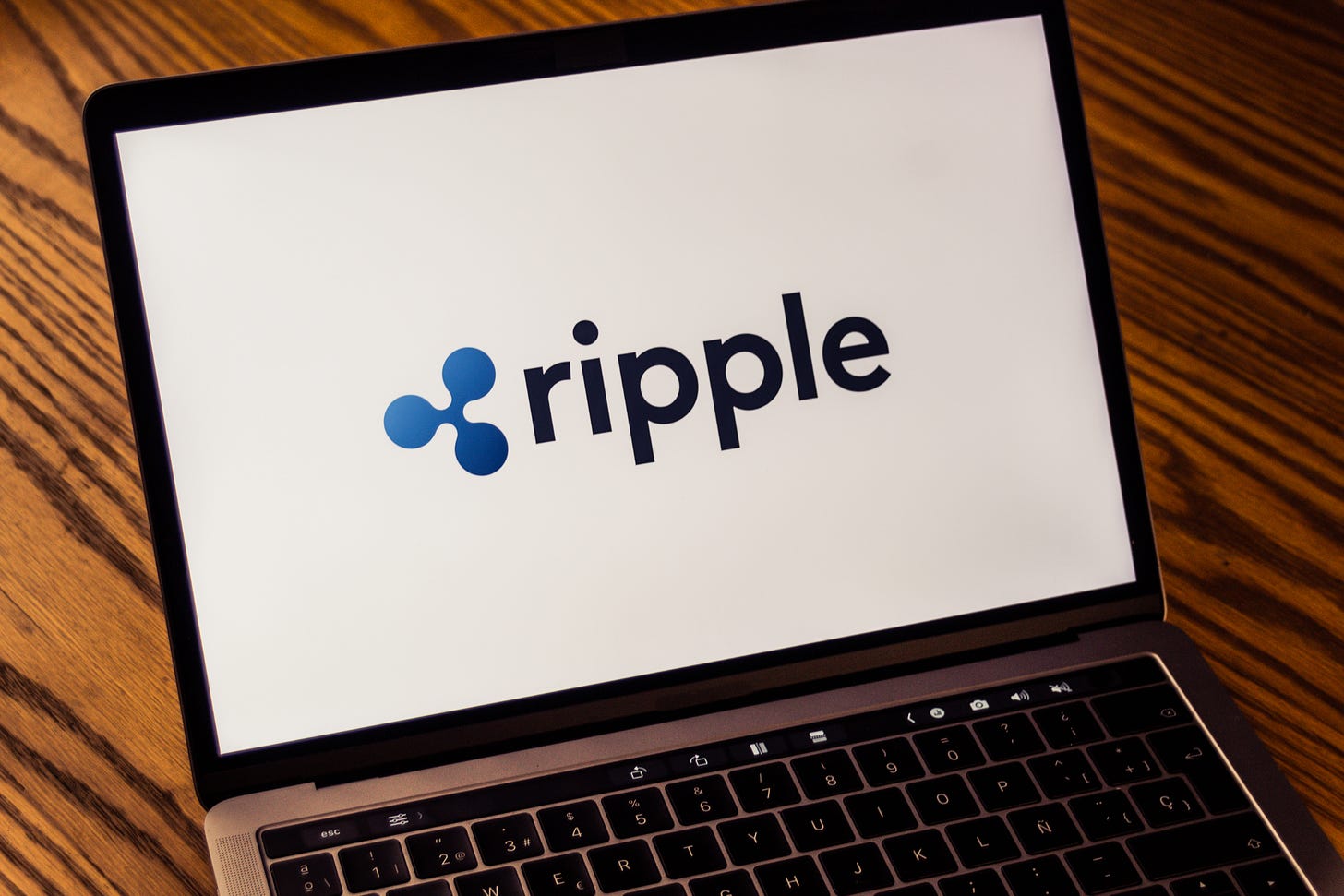Sensei's Morning Forecast: Market Braces for Jobs Data, Ripple Seeks Bank Status
Markets eye U.S. jobs report for rate clues, Ripple files for banking license, FX pressure weighs on global portfolios, and why your portfolio isn’t soaring.
🧠 One Big Thing
The U.S. unemployment rate ticked up to 4.2% in June, with job growth expected to slow sharply to just 85,000–115,000. A jump to 4.3% would keep the Fed in its comfort zone but may fast-track rate cuts if hiring weakens further — potentially reshaping the rate path for the rest of 2025.
💰 Money Move of the Day
Don’t confuse “all-time highs” with real wealth gains. Currency risk has quietly erased S&P 500 returns for many international investors this year — a 10% FX gap can be more damaging than a market correction.
📊 Market Snapshot
Cryptocurrencies:
Bitcoin (BTC): $109,727 (▲ +0.80%)
Ethereum (ETH): $2,594 (▲ +0.89%)
XRP: $2.30 (▲ +2.90%)
Equity Indices (Futures):
S&P 500 (SPX): 6,232 (▲ +0.09%)
NASDAQ 100: 22,853 (▲ +0.04%)
FTSE 100: 8,806 (▲ +0.12%)
Commodities & Bonds:
10-Year US Treasury Yield: 4.259% (▼ -0.56%)
Oil (WTI): $68.06 (▼ -0.46%)
Gold: $3,349 (▼ -0.26%)
🕒 Data as of UK (BST): 12:10 / US (EST): 07:10 / Asia (Tokyo): 20:10
✅ 5 Things to Know Today
US Jobs Report: Labour Market Softening Ahead of Key Fed Policy Decision
The June unemployment report, becomes a critical test for whether the Federal Reserve will accelerate rate cuts after the labour market showed signs of cooling in recent months. The current unemployment rate stands at 4.2%, but economists are watching for a potential rise to 4.3% amid slowing hiring demand (YCharts, Chicago Fed). Wall Street consensus expects nonfarm payrolls to increase by 110,000-115,000 jobs in June, down from 139,000 in May, while the unemployment rate is forecast to tick up to 4.3% from 4.2% (Morningstar, Yahoo Finance). Some economists predict even weaker job growth, with Goldman Sachs forecasting just 85,000 jobs added and RSM estimating 100,000 (Morningstar, RSM). Average hourly earnings are expected to moderate to 0.3% month-over-month from 0.4% in May (AINVEST, Yahoo Finance).
A rise to 4.3% unemployment would still keep the economy well within the Fed's comfort zone, as officials project unemployment to reach 4.5% by year-end (Investing.com, Bankrate). The critical recession indicator—the Sahm Rule—wouldn't trigger until unemployment hits 4.6% on a three-month average basis (Investing.com, Current Market Valuation). However, any reading above 4.3% could accelerate Fed rate cut expectations, particularly if combined with weak job growth below 100,000 (RSM). The Fed currently views the natural rate of unemployment at around 4.2–4.3%, meaning readings above this level signal labor market slack that could justify monetary easing (Investopedia, Federal Reserve). The jobs report will arrive as investors price in approximately 75 basis points of rate cuts this year, with the first cut potentially coming in September (Yahoo Finance, Reuters). A weaker-than-expected report could push the Fed toward more aggressive easing, especially given Chair Powell's recent acknowledgment that the central bank is "attentive to risks on both sides of its dual mandate" (RBC Wealth Management).
Sensei’s Insight: A rise in the unemployment rate to 4.4% may look small, but it tips the scale toward a looser Fed stance—especially if paired with job gains under 100,000. Markets are finely tuned to this pivot point. The Fed doesn’t need a red alert—just a subtle shift in labor dynamics to act.
🏦 Ripple Applies for U.S. Banking License, Follows Circle's Lead in Stablecoin Regulation Push
Ripple Labs applied for a national bank charter from the Office of the Comptroller of the Currency (OCC) on July 2, with CEO Brad Garlinghouse confirming the move to position the company under dual federal and state regulatory oversight (CryptoRank, WSJ). The application includes a Federal Reserve master account request through subsidiary Standard Custody & Trust Company, which Ripple acquired in early 2024 for its New York trust license (Ledger Insights, FundsTech). This would enable Ripple to hold RLUSD stablecoin reserves directly with the Fed, a privilege currently limited to traditional financial institutions.
The move follows Circle's June 30 application for a national trust bank charter to manage USDC reserves, making both companies the latest to pursue federal banking licenses ahead of expected stablecoin legislation (The Block, Cointelegraph). Only Anchorage Digital currently holds a national crypto banking charter, received in 2021 (Anchorage). Three other crypto firms—WisdomTree Digital Trust, Standard Custody & Trust, and Commercium Financial—have also applied for Fed master accounts, signaling industry-wide positioning for regulatory integration (Bitget). Both applications align with the recently passed GENIUS Act, which would require stablecoin issuers to obtain federal banking licenses (Sullivan & Cromwell, Reuters).
Why This Matters: The banking charter pursuit represents a strategic shift from regulatory evasion to compliance-first positioning as federal stablecoin rules crystallize. For Ripple, approval would legitimize RLUSD's $469 million market cap against dominant rivals USDT ($157.8 billion) and USDC ($61.6 billion) (FXStreet, CoinMarketCap). XRP jumped 4% on the news to $2.26, reflecting investor confidence in regulatory clarity (Bitrue). If approved, both Ripple and Circle would gain custodial authority over their own reserves, operational efficiency across state lines, and institutional credibility—potentially accelerating enterprise adoption in the $250 billion stablecoin market (The Crypto Basic).
Sensei’s Insight: Ripple’s bid for a U.S. banking license isn’t just a regulatory move—it’s a signal. As stablecoin legislation tightens, the winners won’t be the fastest movers, but the most compliant. By seeking a Fed master account and OCC charter, Ripple is aiming to elevate RLUSD from altcoin status to bank-grade infrastructure. With Circle following suit and the GENIUS Act laying the groundwork, this is shaping up to be a regulatory arms race. Expect custody rights, direct Fed access, and multi-state operability to become the new crypto trifecta.
💣 Linqto Implodes: $500M Ripple Fraud Probe Rocks Pre-IPO Market
Linqto Bankruptcy Bombshell: Private equity platform Linqto is nearing bankruptcy as the SEC and DOJ investigate $500 million in alleged securities fraud tied to inflated Ripple share prices and unauthorized stock sales by former CEO William Sarris (CryptoSlate, Mitrade). Since February, 13,000 investors have been locked out of accounts, jeopardizing potential seven-figure returns on pre-IPO Ripple shares (Mitrade, GlobeNewswire). New CEO Dan Siciliano, appointed in March, acknowledged “pervasive securities-law violations” and froze all trading. Linqto held 4.7 million Ripple shares purchased on secondary markets, with 11,500 investors believing they owned direct equity through SPVs (Coinpedia, Coingape).
Ripple Valuation Fallout: Federal investigators found that 5,000 investors were non-accredited, violating SEC rules designed to protect retail investors from private-market risks (CryptoSlate, Mitrade). The scandal raises broader concerns about the risks of democratized access to private equity—especially in crypto-linked firms. With Ripple’s June 2025 buyback valuing shares at $175, Linqto’s $800 million Ripple stake is now in legal limbo, and investors may only recover their original capital rather than appreciating gains (Coinpedia, CryptoTimes). The collapse could prompt stricter regulation of pre-IPO platforms, curbing retail access to early-stage investment in blockchain startups (OpenExO, Mitrade).
Sensei’s Insight: When pre-IPO platforms blur the lines between access and accountability, retail investors carry the hidden cost. Linqto’s collapse is more than a fraud case—it’s a referendum on the guardrails of financial inclusion.
Gilts Bounce as Starmer Locks In Reeves
UK government bonds clawed back losses in early trade on Thursday after Prime Minister Keir Starmer assured the BBC that Rachel Reeves “will be the chancellor for a very long time.” Ten-year gilt yields fell 5 basis points to 4.56%, while 30-year yields slipped to 5.37%, trimming part of Wednesday’s sharp sell-off when the 10-year yield had spiked 22 bp to 4.68%—its biggest one-day jump since October 2022 (Bloomberg, Reuters).
The pound steadied around $1.366 as the reassurance tempered concerns that Reeves’ potential exit would loosen the government’s self-imposed fiscal rules and swell future borrowing needs (Bloomberg, Reuters). Why it matters: Bond investors have shown they will punish any hint of fiscal drift; Thursday’s rally suggests credibility can still be regained, but the quick reversal underscores how sensitive UK funding costs remain to political signals. A durable calm hinges on concrete budget plans in the autumn—any slippage could see yields re-price higher, lifting the government’s debt-service bill and tightening financial conditions across the UK economy (Zawya).
Sensei’s Insight: The market’s swift rebound shows just how quickly credibility can be regained—but also how fragile that trust remains. In the dojo of bond markets, discipline must be constant. Starmer’s backing of Reeves was a necessary parry, but without a solid autumn budget, the next strike could come faster and harder.
🇺🇸 U.S. Lifts Chip Design Software Export Restrictions on China
The United States has rescinded export controls on chip design software to China, ending a nearly two-month restriction that had blocked major Electronic Design Automation (EDA) companies from selling their products to Chinese customers without government licenses (AINvest, AA, SCMP). Three global EDA giants—Synopsys, Cadence Design Systems, and Siemens—confirmed Thursday they received notifications from the U.S. Commerce Department's Bureau of Industry and Security that the export restrictions imposed in late May have been lifted, effective immediately (SCMP, CNN, Caixin). The companies are now working to restore access to their software and technology for Chinese customers, with Siemens already fully reinstating services (Caixin, EE Times Asia). The initial restrictions had required these companies to obtain licenses for all sales to China, marking an expansion from previous controls that primarily targeted advanced chip architectures. Synopsys had suspended its financial guidance due to uncertainty, with China representing nearly $1 billion in revenue (16% of total sales) in fiscal 2024 (Yicai Global). Cadence reported $550 million in China revenue (12% of total) for the same period (EE Times Asia).
Why This Matters to Investors: This reversal signals meaningful progress in U.S.-China trade relations following London negotiations in June and represents a significant revenue catalyst for EDA companies. The three firms collectively control approximately 80% of China's EDA market (EE Times Asia), which was valued at $4.2 billion in 2024 and projected to reach $9.2 billion by 2032 (Verified Market Research). The lifting coincides with a broader trade framework where China agreed to expedite rare earth exports to the U.S. in exchange for the removal of American export restrictions on chip software, ethane, and other products (Al Jazeera, NYT). With the 90-day trade truce set to expire in August, this development provides a positive indicator for semiconductor supply chains and suggests potential for further de-escalation in tech trade tensions (Al Jazeera, China Briefing).
Sensei’s Insight: Lifting the EDA software ban unlocks over $1.5B in revenue for U.S. firms and reflects real traction in U.S.-China trade talks. With chip design tools now a bargaining chip alongside rare earths and ethane, this marks a deeper integration of tech policy into trade strategy.
🔗 Connect with Us
Stay plugged in across platforms:
Sensei on X: sensei_crypto_
Martyn Lucas on X: MartynInvestor
Vaz on X: eVTOLHUB
💎 Premium Discord Access: Join the Discord
📺 YouTube Channel (Live & Replays): Martyn Lucas Investor
👕 Limited Merch: Shop Here
🔍 Deeper Dive: SPY Is at All-Time Highs — So Why Isn’t Your Portfolio? + 📈 Chart of the day - VOO (USD) vs VUSA (UK) S&P 500 tracking ETFs
Keep reading with a 7-day free trial
Subscribe to Sensei’s Insights to keep reading this post and get 7 days of free access to the full post archives.









